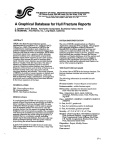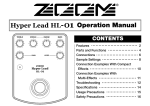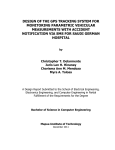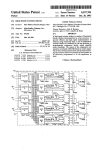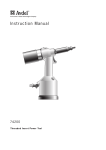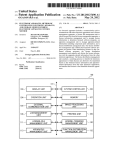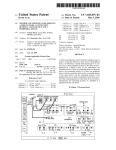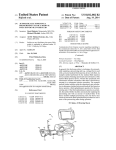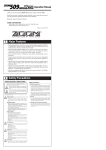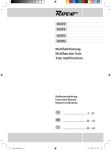Download 1Y1`
Transcript
US 20120239213A1
(19) United States
(12) Patent Application Publication (10) Pub. N0.2 US 2012/0239213 A1
(43) Pub. Date:
Nagata et al.
(54)
(30)
ENERGY DEMAND PREDICTION
APPARATUS AND METHOD
Foreign Application Priority Data
Mar. 15, 2011
(76) Inventors:
(JP) ............................... .. 2011-057137
Publication Classi?cation
Kazumi Nagata, Fuchu-shi (JP);
Kenji Baba, Kodaira-shi (JP);
Takaaki Enohara, Hino-shi (JP);
(51)
Int. Cl.
G06F 1/26
(52)
US. Cl. ...................................................... .. 700/291
(2006.01)
Yasuo Takagi, Chigasaki-shi (JP);
Nobutaka Nishimura, Koganei-shi
(JP); Shuhei Noda, Fuchu-shi (JP)
(57)
13/361,641
An energy demand prediction apparatus according to an
embodiment includes an image analysis unit and a prediction
Jan. 30, 2012
ing at least one of human information and environment infor
mation of a prediction target area based on image data
Related US. Application Data
acquired by an image sensor. The prediction unit generates
prediction data by executing an energy demand prediction
(21) App1.No.:
(22)
Sep. 20, 2012
Filed:
ABSTRACT
unit. The image analysis unit generates analysis data includ
based on the analysis data and an energy demand prediction
model generated using previous data corresponding to the
analysis data.
(63) Continuation of application No. PCT/J P201 1/ 078684,
?led on Dec. 12, 2011.
136s
Waggon r8
‘:1
Device
,
control unit
Control data (Lighting)
27
Control data (Aircondition) 27\
i _______ "
_:lr\
I‘
_
1'“
i
i,
i
i
I
'
+
q‘
l|
'l
:l
i:
i 91
‘a
‘it’
-
‘2
1Y1’
‘
g
24
_
22a Human information,
5
22b Environmentinformation
<—_'
29 image processing sewer
i“
*1»
; lmaélgdata i
>
_
"- ———————— ——:
=
ima e
_,_
anaiyslgs unit 7
Iv~27C0ntr0| data (Blind driving)
Patent Application Publication
52@S1 HE: mn$3wsE5228o
NH
Sep. 20, 2012 Sheet 2 0f 4
QNKCEm68 m30g5 mmméNR=532 m
5QEo:eN8cgé2m 4
mwmé5:3265: Wm
69%2585
R
w22%250i/R
.28w
‘IHI|l{mwLHliFmuNH
1“
m
M
m
2
a
US 2012/0239213 A1
Patent Application Publication
Sep. 20, 2012 Sheet 3 0f 4
Pro cessor
30*”
moqel
.
r3
analysis unit J‘31
generatlon unit
4
\
4
l/ \\\ /1/
v
4
Environment
Environment
Environment
lI
ll
l1
22b
32
33
information
model
analysls data
Pr cessor
°
Human model
»3
Human
34*” generation unit
/
US 2012/0239213 A1
\
analysis unit “f 35
‘xi /
v
Human
Human
Human
information
model
analysis data
ll
ll
ll
22a
36
37
FlG.4
4
Sep. 20, 2012
US 2012/0239213 A1
ENERGY DEMAND PREDICTION
APPARATUS AND METHOD
based on the analysis data and an energy demand prediction
model generated using previous data corresponding to the
analysis data.
CROSS REFERENCE TO RELATED
APPLICATIONS
[0001] This application is a Continuation Application of
PCT Application No. PCT/JP2011/078684, ?led Dec. 12,
201 1 and based upon and claiming the bene?t of priority from
prior Japanese Patent Application No. 2011-057137, ?led
Mar. 15, 2011, the entire contents of Which are incorporated
herein by reference.
BACKGROUND OF THE INVENTION
[0002] 1. Field of the Invention
[0003] An embodiment of the present invention relate to an
apparatus and method predicting an energy demand of vari
ous facilities.
[0004]
[0005]
2. Description of the Related Art
In recent years, prevention of global Warming and
reduction of environmental loads have received attention. For
example, it is required to make use of capabilities of appara
tuses for energy saving, creation, and storage equipped in
facility such as a building, factory, and plant, so as to attain
BRIEF DESCRIPTION OF THE SEVERAL
VIEWS OF THE DRAWING
[0012] FIG. 1 is a block diagram shoWing an example of an
arrangement of an energy demand prediction apparatus
according to a ?rst embodiment;
[0013] FIG. 2 is a block diagram shoWing an example of an
energy demand prediction system including the energy
demand prediction apparatus according to the ?rst embodi
ment;
[0014]
FIG. 3 is a block diagram shoWing an example of an
environment model generation unit and environment analysis
unit according to a second embodiment;
[0015] FIG. 4 is a block diagram shoWing an example ofa
human model generation unit and human analysis unit
according to a third embodiment; and
[0016] FIG. 5 is a block diagram shoWing an example of an
arrangement of an energy demand prediction apparatus
according to a fourth embodiment.
DETAILED DESCRIPTION OF THE INVENTION
[0017] Embodiments of the present invention Will be
described hereinafter With reference to the draWings. Note
unWasted and ef?cient energy management.
[0006] In order to attain energy management such as
demand control, an accurate energy demand prediction is
that the same reference numerals denote the same or nearly
required.
tion thereof Will be given, and only differences Will be
[0007] As an example of the energy demand prediction, a
method of executing the energy demand prediction based on
information including electric poWer usages, Weather, tem
the same components throughout the accompanying draW
ings, a description thereof Will not be given or a brief descrip
described in detail.
First Embodiment
perature, schedule (business day, no-business day, or singu
[0018]
larity), and the like is available.
[0008] This conventional energy demand prediction uses,
prediction apparatus, Which analyZes image data acquired by
for example, measurement values of physical sensors such as
least one of human information and environment informa
a thermometer, hygrometer, illuminometer, and electric
poWer data.
[0009] HoWever, When the energy demand prediction is
executed using only the measurement values of the physical
sensors, the accuracy does not often suf?ce.
This embodiment Will explain an energy demand
an image sensor to generate image analysis data including at
tion, Which dynamically change in an energy demand predic
tion area, and executes an energy demand prediction based on
the image analysis data. Furthermore, in this embodiment, the
energy demand prediction may be executed further using, for
example, information such as a temperature, humidity,
Weather, schedule, electric poWer usages and the like in addi
tion to the image analysis data.
BRIEF SUMMARY OF THE INVENTION
[0019] The energy demand prediction apparatus according
to this embodiment accurately measures, for example, data
Technical Problem
[0010]
The embodiment of the present invention have as an
object to provide an energy demand prediction apparatus and
method, Which improve an accuracy of an energy demand
prediction.
Solution to Problem
[0011] In an embodiment, an energy demand prediction
apparatus includes an image analysis unit and a prediction
unit. The image analysis unit generates analysis data includ
ing at least one of human information and environment infor
mation of a prediction target area based on image data
acquired by an image sensor. The prediction unit generates
prediction data by executing an energy demand prediction
such as environment information, electric energy, and human
activity information in an energy demand prediction area by
analyZing the image data, thus attaining an accurate energy
demand prediction.
[0020]
FIG. 1 is a block diagram shoWing an example of an
arrangement of the energy demand prediction apparatus
according to this embodiment.
[0021] An energy demand prediction apparatus 1 includes
an input control unit 2, processor 3, storage device 4, and
output control unit 5.
[0022]
The processor 3 functions as an image analysis unit
7, prediction unit 8, and device control unit 24 by executing a
program 6 stored in the storage device 4. Note that the image
analysis unit 7, prediction unit 8, and device control unit 24
may be implemented by hardWare in the energy demand
prediction apparatus 1.
Sep. 20,2012
US 2012/0239213 A1
[0023]
The energy demand prediction apparatus 1 is con
nected to an image sensor 9, infrared sensor 10, laser sensor
personal speci?c information of a person Who is in the energy
demand prediction area, and the like.
11, measurement devices 121 to 1211, building automation
[0037]
system (BAS: building monitoring system) 13, and environ
extracts a feature amount from the image data 16, infrared
ment management system (EMS) 14 to be able to receive
various data associated With an energy demand prediction
area. Furthermore, the energy demand prediction apparatus 1
is connected to an output device 15 and control target devices
nition processing and the like based on the extracted feature
amount and set criteria, thus generating the environment
information 22b.
The environment information generation unit 7b
image data 17, and laser image data 18, and executes recog
251 to 25m.
[0038]
[0024] The image sensor 9 includes, for example, a camera,
image capturing device, visible camera, or the like.
[0025] The infrared sensor 10 includes, for example, an
information such as an illuminance, amount of solar radia
tion, a blind opening/closing amount, incident state of sun
The environment information 22b includes light
infrared camera or the like.
light, and the like, layout information such as the presence/
absence, location, and number of o?ice devices, the location
[0026] The laser sensor 11 measures a laser beam. The laser
sensor 11 includes, for example, a laser camera.
and number of doorWay and a WindoW of an o?ice, and a
location of a path, the locations and numbers of heat sources
The devices 121 to 1211 include, for example, physi
and poWer consuming devices, Weather information, and the
cal sensors such as a thermometer, hygrometer, illuminom
like.
[0039] The prediction unit 8 executes the energy demand
prediction based on the analysis data 22, the device data 191
to 1911, the BAS data 20, the EMS data 21, and an energy
[0027]
eter, and electric poWer meter, and other devices. The devices
121 to 1211 acquire a temperature, humidity, illuminance,
electric poWer information, Weather information, schedule
information, and the like.
[0028] The BAS 13 controls, monitors, and manages air
conditioning, heat sources, illuminations, reception and
transformation of electric energy, disaster prevention, secu
rity, and the like in a building.
[0029] The EMS 14 manages an environment of the energy
demand prediction area.
[0030] The devices 251 to 25m include devices as control
targets such as air-conditioner, lighting devices, blind driving
devices, curtain driving devices, and the like, Which are
installed Within the energy demand prediction area.
[0031] The input control unit 2 controls the storage device
4 to store image data 16, infrared image data (infrared mea
surement data) 17, and laser image data (laser measurement
demand prediction model (prediction formula) stored in the
storage device 4, and generates prediction data 23. Then, the
prediction unit 8 stores the prediction data 23 in the storage
device 4. In this Way, using the analysis data 22 Which
changes dynamically in the energy demand prediction, a ?ex
ible and accurate prediction can be attained.
[0040] The energy demand prediction model is generated
based on previous data including previous analysis data 22,
previous device data 191 to 1911, previous BAS data 20, and
previous EMS data 21, and a previous energy consumption
amount corresponding to this previous data. Using the energy
demand prediction model, a future energy (electric poWer)
device 4 to store device data 191 to 1911 acquired by the
demand prediction can be executed.
[0041] The device control unit 24 executes control process
ing for the control target devices 251 to 25m associated With
the energy demand prediction area based on the prediction
data 23, the human information 2211 and environment infor
mation 22b in the analysis data 22, the device data 191 to 1911,
devices 121 to 1211.
and control setting data 26 stored in the storage device 4, and
[0033]
generates control data 27 including at least one of control
instructions and control values for the devices 251 to 25m.
Then, the device control unit 24 stores the control data 27 in
the storage device 4.
[0042] In this case, the control setting data 26 includes
individual user information, individual attribute data, and
individual comfort state information of persons. Also, the
data) 18, Which are respectively acquired by the image sensor
9, infrared sensor 10, and laser sensor 11.
[0032]
Also, the input control unit 2 controls the storage
Furthermore, the input control unit 2 inputs BAS
data 20 of the BAS 13 and EMS data 21 of the EMS 14, and
controls the storage device 4 to store these data.
[0034] The image analysis unit 7 executes analysis process
ing for the image data 16, infrared image data 17, and laser
image data 18 stored in the storage device 4, generates analy
sis data 22 including human information 2211 and environ
ment information 22b, and stores the analysis data 22 in the
storage device 4. The image analysis unit 7 implements func
tions as a human information generation unit 711 and environ
ment information generation unit 7b.
[0035] The human information generation unit 711 extracts
feature amounts from the image data 16, infrared image data
17, and laser image data 18, and executes recognition pro
cessing and the like based on the extracted feature amounts
control setting data 26 includes control values corresponding
to human action states (an action sensitive to heat, that sen
sitive to the cold, during a desk Work, during stand talking,
during Walking).
[0043]
For example, the device control unit 24 generates
the control data 27 based on the prediction data 23, so that an
energy demand fall Within a predetermined value range.
and set criteria, thereby generating the human information
Thus, energy saving, creation, and storage can be attained.
[0044] Also, the device control unit 24 may generate the
2211.
control data 27 for the devices 251 to 25m based on the human
[0036]
The human information 22a includes the presence/
absence of a person, the number of persons, a distribution/
information 2211 in the analysis data 22, and the control set
ting data 26 including the user information, attribute data,
density of the persons, an amount of activity of the person, an
individual comfort state information, and control values cor
amount of clothing of the person, a personal attribute (name,
responding to personal actions, Which are stored in the stor
age device 4.
[0045] The device control unit 24 identi?es an individual
gender, body type, body height, age, etc.), a position of the
person (standing position, seated position, etc.), and an activ
ity state (during of?ce Work, transfer, conversation, and so
forth) of a person in the energy demand prediction area,
based on the human information 22a, and generates the con
trol data 27 for practicing a comfort state set for this indi
US 2012/0239213 A1
Sep. 20, 2012
vidual in the control setting data 26. For example, the device
control unit 24 may generate the control data 27 for practicing
control set for the action state in the control setting data 26
attribute information and favor information of the individuals
set in the control setting data 26.
[0056] The control data 27 obtained as a result of the device
based on the human action state (an action sensitive to heat,
control is transmitted to, for example, the control target
devices 251 to 25m such as air-conditioners, lighting devices,
blind driving devices, and the like.
[0057] In the aforementioned energy demand prediction
apparatus 1, an energy demand prediction model is generated
that sensitive to the cold, during a desk Work, during stand
talking, during Walking) included in the human information
2211.
[0046]
The output control unit 5 outputs the prediction data
23 and various other data stored in the storage device 4 to the
output device 15.
to be able to predict an energy demand based on the human
control data 27 stored in the storage device 4 to the devices
information 2211 and environment information 22b in addi
tion to information including the electric poWer usages,
251 to 25m.
Weather, temperature, schedule (business day, no-business
[0048]
day, or singularity), and the like.
[0058] The energy demand prediction model is built up
[0047]
Furthermore, the output control unit 5 outputs the
The output device 15 includes, for example, a dis
play device, audio output device, communication device, and
the like, and displays, audibly outputs, and transmits the
prediction data 23 and various other data.
[0049] The devices 251 to 25m operate based on the control
data 27. The devices 251 to 25m include, for example, air
conditioners, lighting devices, blind driving devices, and the
like.
[0050]
FIG. 2 is a block diagram shoWing an example of an
energy demand prediction system including the energy
demand prediction apparatus 1 according to this embodi
ment.
[0051] Image sensors 91 and 92 are installed respectively
for energy demand prediction areas 281 and 282. The image
using statistical predictions based on previous data, deriva
tions of regression expressions for the previous data, use of
physics formulas based on theories, and the like. For example,
the prediction based on the energy demand prediction model
is accurately done in real time. The energy demand prediction
model built up With reference to the previous data executes
future energy demand predictions based on actual state data
of the energy demand prediction areas 281 and 282.
[0059] Note that in this embodiment, image analysis uses
data acquired by the image sensor 9, infrared sensor 10, and
o?ice or an outdoor, and capture images of the of?ce. The
laser sensor 11. HoWever, all of these data need not alWays be
used. That is, arbitrary one of the image sensor 9, infrared
sensor 10, and laser sensor 11 may be installed. Alternatively,
image sensors 91 and 92 may include a visible camera, infra
tWo or more sensors for at least one type of the image sensor
red camera, and the like. Image data 16 acquired by the image
9, infrared sensor 10, and laser sensor 11 may be installed.
Alternatively, data acquired by another sensor such as a
thermo sensor (heat source sensor) may be used in image
analysis. Alternatively, one or a plurality of acquired data may
sensors 91 and 92 are installed on, for example, a ceiling of an
sensors 91 and 92 are stored in a memory area, Which is
prepared in advance. The image analysis unit 7 of an image
processing server 29 analyZes the captured image data 16 to
generate the human information 22a and environment infor
mation 22b. The image processing server 29 transmits the
human information 2211 and environment information 22b to
the BAS 13. Note that the functions of the image analysis unit
7 may be included in the image sensors 91 and 92. In this case,
the need for the image processing server 29 can be obviated.
[0052] The BAS 13 executes generating the prediction data
23 by the prediction unit 8 and device controlling by the
device control unit 24 using the human information 2211 and
environment information 22b, in addition to building man
agement.
[0053]
For example, the prediction unit 8 executes the
energy demand prediction based on the human information
22a and environment information 22b, the device data 191 to
1911 from other devices 121 to 1211, andthe BAS data 20 Which
is used by the BAS 13 and includes device use states, electric
poWer usages, and the like.
[0054] Note that the building management such as OK/NG
determination of a human action, and the energy demand
be selected and used in image analysis.
[0060] A practical example Will be explained beloW. In this
embodiment, the human information 2211 is generated mainly
using the image sensor 9, and correspondence processing to a
demand response (for example, an energy consumption
reduction request from a poWer company) and demand pre
diction are executed based on this human information 22a. By
contrast, for example, the human information 22a may be
generated using a thermo sensor, laser sensor 11, a sensor
detecting a presence of person based on a technology, and the
human information 2211 may be used in the correspondence
processing to the demand response and demand prediction.
[0061] In the aforementioned embodiment, The energy
demand is predicted based on the human information 22a and
environment information 22b generated based on the image
data 16 in addition to the device data 191 to 1911 acquired by
the device sensors 121 to 1211. Thus, the prediction accuracy
can be improved.
prediction by the prediction unit 8 may be executed by
[0062] Also, using the image sensor 9 and image analysis
another computer in place of the BAS 13.
[0055] The device control unit 24 speci?es individuals Who
unit 7, the number of pieces of effective information used in
are staying in the energy demand prediction areas 281 and
282 based on the human information 2211. Also, the device
control unit 24 speci?es states (sensitive to heat, sensitive to
the cold, etc.) and actions (during a desk Work, during stand
talking, during Walking, etc.) of individuals based on the
human information 22a. Furthermore, the device control unit
24 executes device control Which matches attributes, states,
actions, and favors of respective individuals based on
the energy demand prediction can be increased Without
installing sensors of various other types, and information
Which changes dynamically can be effectively used in the
prediction, thus attaining a cost reduction.
[0063] In this embodiment, the device control Which
matches an attribute of a recogniZed individual and re?ects a
personal favor can be executed based on the device data 191
to 1911, human information 2211, environment information
22b, and control setting data 26.
Sep. 20, 2012
US 2012/0239213 A1
[0064] In this embodiment, accurate and plenitude data,
that is, the analysis data 22, device data 191 to 1911, BAS data
20, and EMS data 21 can be used as the previous data and
actual state data.
[0065]
In this embodiment, the accurate energy demand
prediction model can be built up using information such as a
temperature and humidity, Which are measured using physi
cal sensors such as the device sensors 121 to 1211, electric
poWer information such as electric poWer usages of the
devices 251 to 25m in the energy demand prediction area, and
the human information 2211 and environment information 22b
acquired based on the image sensor 9.
[0066]
In this embodiment, the energy demand prediction,
recognition of the opening/closing amount and opening/clos
ing angle of the blind is done using the blind state, opening/
closing amount, and opening/ closing angle of the image data
16, Which are stored in the database.
[0071] The presence/absence and location of an of?ce
device, the number of o?ice devices, and of?ce layout infor
mation are obtained by executing recognition processing of
an object such as o?ice device and the like to the image data
16. The representative of?ce device (desk, chair, display, PC,
printer, partition, Whiteboard, etc.) is recognized using a mea
surement of an object shape, a relationship of an object lay
out, or a learning technique. A direction and a size of the
Which can maintain an optimal energy balance, can be
object in the image data 16 change depending on a positional
relationship betWeen the image sensor 9 and the object. The
executed at year-, month-, day-, hour-, or second-intervals or
in real time.
change and correctly recognizes the object using various
[0067]
In this embodiment, the energy demand prediction
learning techniques and the like. Thus, at the time of, for
can be executed for various energy demand prediction areas
281 and 282 such as a building, ?oors, areas, and zones.
example, a layout change of an of?ce or the like, the need for
the user to manually input information can be obviated, and
the environment information generation unit 7b can instanta
[0068]
In this embodiment, the electric poWer information
can be measured or acquired by the BAS 13 or electric poWer
meter. Furthermore, in this embodiment, electric poWer use
states of the respective devices can be estimated for the
environment information generation unit 7b absorbs such a
neously and automatically recognize a neW layout. The image
sensor 9 can be installed outdoors. The environment informa
respective energy demand prediction areas 281 and 282 based
tion generation unit 7b can generate Weather information,
spatial information of a building to be analyzed, and layout
on at least one of the human information 2211 and environment
information 22b. In response to a demand response, the
device control unit 24 selects a device, Which is not in use but
data 16 of the outdoor. Also, the environment information
generation unit 7b can generate information such as a longi
Whose poWer supply is ON, based on the image data 16 from
the image sensor 9, and can turn off the poWer supply of the
building to be measured based on a positional relationship
information of a surrounding building by analyzing the image
tude and latitude of a measurement place, and a direction of a
selected device. Therefore, in this embodiment, the device
With the sun or stars.
control unit 24 can ?exibly executes control for the demand
response.
[0072] Various kinds of information included in the envi
ronment information 22b may be able to be acquired from
Second Embodiment
various dedicated sensors. HoWever, by acquiring various
kinds of information by analyzing the image data 16 obtained
by the image sensor 9, since the need for installing individual
[0069]
This embodiment Will explain the environment
information 22b according to the ?rst embodiment more
practically.
[0070]
As described above, the environment information
22b includes light information such as an illuminance,
amount of solar radiation, blind opening/closing amounts,
and incident amount of sunlight, layout information such as
the presence/absence, locations, and number of of?ce
devices, the numbers and locations of doorWays and Win
doWs, and a location of a path, the locations and numbers of
heat sources and poWer consuming devices, Weather informa
tion, and the like. The environment information 22b can be
acquired by analyzing the image data 16 of the image sensor
dedicated sensors can be obviated, a cost reduction can be
achieved. Of the environment information 22b, the layout
information, Weather information, and the like can be
acquired When they are manually input by a user. HoWever,
using the image sensor 9, these pieces of information can be
acquired in real time, thus obviating the need of user’s manual
inputs.
[0073]
The environment information generation unit 7b
can calculate and estimate, as the environment information
22b, a measurement value at a certain point, a measurement
value Within a designated range, a value of a Whole room, a
value of a Whole ?oor, and a value of a Whole building.
9 installed in an o?ice. For example, the illuminance can be
[0074]
calculated by setting, in advance, a luminance distribution on
the image data 16 of a certain object under given conditions.
Luminance levels according to illuminance levels are stored
environment model generation unit and environment analysis
unit according to this embodiment. Note that FIG. 3 mainly
in a database based on a change in luminance on the image
[0075] The processor 3 executes the program 6, Which is
not shoWn in FIG. 3, thereby implementing functions as an
environment model generation unit 30 and environment
data 16 caused by a change in illuminance, and image sensor
parameters. Learning or updating of illuminance calculations
are made using illuminance and luminance levels stored in the
database. As for a blind, the environment information gen
eration unit 7b recognizes a location of the blind by means of
object recognition for the image data 16 or manual inputs.
Then, the environment information generation unit 7b detects
a change of the blind in the image data 16, and recognizes a
opening/closing amount and opening/closing angle of the
blind. The state, opening/closing amount, and opening/clos
ing angle of the blind calculated from the image data 16 are
stored in a database. Learning or updating associated With
FIG. 3 is a block diagram shoWing an example of an
shoWs components Which are not shoWn in FIG. 1 above.
analysis unit 31.
[0076] The environment model generation unit 30 gener
ates an environment model 32 of an energy demand predic
tion area using a model automatic generation technique (for
example, a model automatic generation tool) based on the
environment information 22b stored in the storage device 4.
For example, the environment model 32 represents a feature
and characteristic of the environment. Then, the environment
model generation unit 30 stores the environment model 32 in
the storage device 4.
Sep. 20, 2012
US 2012/0239213 A1
[0077]
The environment analysis unit 31 executes restora
tion of a three-dimensional space, estimation of a temperature
and humidity, estimation of heat and Wind, air-conditioning
simulation, and the like based on the environment model 32,
and generates environment analysis data 33. Then, the envi
ronment analysis unit 31 stores the environment analysis data
33 in the storage device 4.
[0078] The output control unit 5 outputs the environment
analysis data 33 to the output device 15, Which is not shoWn in
FIG. 3.
[0079]
information 22a stored in the storage device 4. For example,
the human model 36 represents a feature and characteristic of
a person. Then, the human model generation unit 34 stores the
human model 36 in the storage device 4.
[0089] The human analysis unit 35 executes an action pre
diction of a person and air-conditioning and lighting simula
tions according to the action of the person based on the human
model 36, and generates human analysis data 37. Then, the
human analysis unit 35 stores the human analysis data 37 in
the storage device 4.
In this embodiment, the environment model 32 is
[0090]
The output control unit 5 outputs the human analysis
built up based on the environment information 22b, and res
toration of the three-dimensional space, estimation of the
data 37 to the output device 15.
temperature and humidity, estimation of heat and Wind, air
energy demand prediction area is built up based on the human
conditioning simulation, and the like can be executed based
information 22a, and the action prediction, the air-condition
ing and lighting simulations according to the action of the
on the environment model 32.
[0080]
The environment information 22b may be used in
[0091]
In this embodiment, the human model 36 in the
combination With various kinds of information (for example,
indoor and outdoor temperature and humidity values, a Wind
person, and the like can be executed based on the human
model 36.
[0092] The human information 22a may be used in combi
speed, a C02 concentration, Weather, etc.) acquired by nor
nation With information from a building central monitoring
mal sensors, and information from the BAS 13.
[0081] Furthermore, the environment information 22b can
tem.
improve the measurement accuracy using the human infor
system, entry/leave management system, and security sys
mation 22a.
[0093] Furthermore, the human information 2211 can
improve the measurement accuracy using the environment
[0082]
information 22b.
The environment analysis unit 31 of this embodi
ment may predict a condition of another ?oor from a condi
tion of one ?oor based on the environment information 22b.
Third Embodiment
[0083]
[0094]
The human analysis unit 35 according to this
embodiment may predict a condition of another ?oor from a
condition of one ?oor in association With the human infor
mation 2211.
This embodiment Will explain the human informa
tion 2211 according to the ?rst embodiment more practically.
[0084] As described above, the human information 22a
includes information such as the presence/absence of the
person or the number of persons, the distribution, the amount
of activity, the amount of clothing, the attribute (name, gen
der, body type, body height, age, etc.), the position (standing
position, seated position, etc.), and the activity state (o?ice
Work, transfer, conversation, etc.) of the person in the energy
demand prediction area. The human information 22a is
acquired by analyZing the image data 16 of the image sensor
9 installed in an of?ce. The human information generation
unit 711 extracts a motion of a person by analyZing a change in
luminance in time and a spatial direction of the image data 16.
The human information generation unit 711 identi?es a person
and another object, and identi?es its action and behavior. A
target to be identi?ed by the human information generation
unit 711 is stored in a database, and a learning technique is
applied to the identi?cation by the human information gen
eration unit 711.
[0085] The human information generation unit 711 can cal
Fourth Embodiment
[0095]
This embodiment Will explain modi?cations of the
?rst to third embodiments described above.
[0096] FIG. 5 is a block diagram shoWing an example of an
arrangement of an energy demand prediction apparatus
according to this embodiment. FIG. 5 mainly shoWs only
components Which are not shoWn in FIG. 1 above.
[0097] The processor 3 executes the program 6, Which is
not shoWn in FIG. 5, thereby functioning as a model selection
unit 38, coe?icient correction unit 39, updating unit 40, data
replenishment unit 41, and singularity determination unit 42.
These units Will be described beloW.
[0098]
[Model Selection Unit 38]
[0099] The storage device 4 stores a plurality of energy
demand prediction models 431 to 43k, and model feature data
441 to 44k Which respectively indicate features of the plural
ity of energy demand prediction models 431 to 43k
[0100]
The plurality of energy demand prediction models
431 to 43k and the corresponding model feature data 441 to
culate and estimate, as the human information 22a, a mea
surement value at a certain point, a measurement value Within
44k are associated With each other.
[0101] The model feature data 441 to 44k are used as cri
a designated range, a value of a Whole room, a value of a
teria required to select an appropriate model from the plural
ity of energy demand prediction models 431 to 43k
[0102] The model selection unit 38 selects, based on data
Whole ?oor, and a value of a Whole building.
[0086] FIG. 4 is a block diagram shoWing an example of a
human model generation unit and human analysis unit
according to this embodiment. Note that FIG. 4 mainly shoWs
components, Which are not shoWn in FIG. 1 above.
[0087] The processor 3 executes the program 6, Which is
not shoWn in FIG. 4, thereby implementing functions as a
human model generation unit 34 and human analysis unit 35.
[0088] The human model generation unit 34 generates a
human model 36 in an energy demand prediction area using a
model automatic generation technique based on the human
such as current (latest) human information 2211, current envi
ronment information 22b, and current device data 191 to 1911,
model feature data Which matches a content indicated by the
current data from the model feature data 441 to 44k. Then, the
model selection unit 38 selects an energy demand prediction
model corresponding to the selected model feature data.
[0103] The prediction unit 8 executes an energy demand
prediction based on the energy demand prediction model
selected by the model selection unit 38.
Sep. 20, 2012
US 2012/0239213 A1
[0104] In this embodiment, a plurality of energy demand
prediction models are prepared in accordance With previous
replenishment unit 41 estimates the electric poWer usages of
data tendencies.
[0105] In this embodiment, an energy demand prediction
model optimal to the current energy demand prediction area
can be selected from the plurality of energy demand predic
tion models 431 to 43k. For example, even When previous
data, Which Were referred to upon building up a certain energy
the human information 2211, the environment information
22b, and the like, Which can be acquired.
the devices 251 to 25m based on electric poWer information,
[0117]
For example, the data replenishment unit 41 deter
mines that a personal computer, Which is placed in front of a
Working person, is ON, and estimates an electric poWer usage
based on his or her attending time. As for a printer and a
demand prediction model, include the same Weather or sea
copying machine, their electric poWer usages are estimated in
son as the current Weather or season, When the number of
the same manner as that personal computer.
persons in a room upon building up the model is different
from the current number of persons in the room, the model
selection unit 38 gives priority to a head-count condition over
the previous Weather or season, and selects an energy demand
prediction model Which matches the head-count condition.
[0106] Thus, the prediction accuracy can be improved.
[0107]
[Coef?cient Correction Unit 39]
[01 08] The coef?cient correction unit 39 automatically cor
rects coef?cients of the energy demand prediction models
[0118]
For example, the data replenishment unit 41 esti
mates an electric poWer user amount of each room based on an
electric poWer user amount of a Whole ?oor and attending
conditions of respective rooms.
[0119]
For example, the data replenishment unit 41 esti
mates or predicts use conditions of of?ce devices based on a
layout of each room and a distribution of the number of
persons, and can re?ect them to the energy demand predic
tion.
431 to 43k based on data such as the acquired human infor
[0120]
mation 22a, environment information 22b, and device data
191 to 1911. Thus, the prediction accuracy can be improved.
[0109] More speci?cally, the coe?icient correction unit 39
corrects the coef?cients of the energy demand prediction
mates or calculates a measurement item for an area Without
any sensors based on data of an area installed With a sensor.
models 431 to 43k based on the current information or infor
mation including time-serial changes such as an increase or
decrease in the number of persons in a building or ?oor, a
persons based on human information acquired from sur
Weather or cloud condition, and incident sunlight. For
example, When the number of persons on a floor is increased
immediately, the coe?icient correction unit 39 adjusts a coef
?cient corresponding to the number of persons, so as to build
up an energy demand prediction model Which matches the
actual state, thereby minimiZing a difference betWeen an
actual energy demand and a predicted value.
[0110] [Updating Unit 40]
[0111] The updating unit 40 updates (sequentially updates)
the energy demand prediction models 431 to 43kbased on the
current data such as the human information 2211, environment
information 22b, and device data 191 to 1911 every time a
predetermined period elap ses. For example, the updating unit
40 sequentially updates the energy demand prediction models
431 to 43k using data acquired a day ahead, data acquired an
hour earlier, and data acquired a minute earlier. Updating of
For example, the data replenishment unit 41 esti
[0121] For example, the number of persons of an area With
out any image sensor can be calculated by estimating ?oWs of
rounding image sensors.
[0122] Thus, the prediction accuracy can be improved, and
cost can be reduced compared to a case in Which all values are
measured using sensors.
[0123]
[Singularity Determination Unit 42]
[0124] The singularity determination unit 42 executes, for
example, comparison processing With a threshold based on
the acquired data such as the human information 2211, envi
ronment information 22b, and device data 191 to 1911, thus
determining or predicting a singularity. Then, the singularity
determination unit 42 stores singularity determination data 46
indicating a determination result in the storage device 4.
[0125] For example, various components such as the model
selection unit 38, coef?cient correction unit 39, updating unit
40, and data replenishment unit 41 execute their processes
using the singularity determination data 46.
[0126] A day (singularity) such as an anniversary of foun
dation of a company, Which is different from a normal day, has
the energy demand prediction models 431 to 43k can use
an energy demand tendency different from the normal day.
various model automatic generation techniques.
[0112] In this embodiment, the energy demand prediction
models 431 to 43kare sequentially updated using not only the
Hence, energy demands have to be carefully predicted.
[0127] For example, different energy demand prediction
human information 22a and environment information 22b
acquired by the image sensor but also the device data 191 to
1911 such as electric poWer information, Weather information,
models are prepared for a business day and a singularity, and
it is important to recogniZe the singularity. As a setting of the
singularity, a schedule may be manually input. HoWever, the
[0113] [Data Replenishment Unit 41]
same energy demand prediction as that of the singularity is
often exhibited on an unexpected day. For this reason, the
singularity determination unit 42 determines or predicts a
[0114]
singularity based on the image data 16 acquired by the image
or the like, thus improving the prediction accuracy.
The data replenishment unit 41 calculates replenish
ment data 45 effective for the energy demand prediction
based on the acquired data such as the human information
22a, environment information 22b, and device data 191 to
1911. Then, the data replenishment unit 41 stores the replen
ishment data 45 in the storage unit 4.
[0115] For example, various components such as the model
selection unit 38, coe?icient correction unit 39, and updating
unit 40 execute their processes using the replenishment data
45 calculated by the data replenishment unit 41.
[0116] For example, When the electric poWer usages of the
devices 251 to 25m cannot be directly acquired, the data
sensor 9. Thus, an unexpected energy demand variation can
be coped With in advance.
[0128] The singularity determination unit 42 determines or
predicts a singularity using an increase or decrease in the
number of persons, a How of persons, the number of transfer
ring persons, a head-count distribution on respective ?oors,
their time-serial changes, and the like included in the human
information 2211 mainly obtained from the image data 16.
Thus, energy demand tendency of a Whole building, Whole
?oor, and Whole room can be predicted, thus improving the
energy demand prediction accuracy of the Whole building.
Sep. 20, 2012
US 2012/0239213 A1
[0129] For example, for a singularity, an energy demand
prediction model can be sWitched.
the energy demand prediction apparatus further comprises:
a human model generation unit that generates a human
Additional advantages and modi?cations Will
model Which represents a feature of a person Who are
readily occur to those skilled in the art. Therefore, the inven
tion in its broader aspects is not limited to the speci?c details
staying in the prediction target area based on the human
information.
[0130]
and representative embodiments shoWn and described herein.
Accordingly, various modi?cations may be made Without
departing from the spirit or scope of the general inventive
concept as de?ned by the appended claims and their equiva
lents.
What is claimed is:
1. An energy demand prediction apparatus comprising:
an image analysis unit that generates analysis data includ
ing at least one of human information and environment
information of a prediction target area based on image
data acquired by an image sensor; and
a prediction unit that generates prediction data by execut
ing an energy demand prediction based on the analysis
data and an energy demand prediction model generated
using previous data corresponding to the analysis data.
2. The energy demand prediction apparatus of claim 1,
Wherein the previous data includes previous data acquired by
a device sensor, and
the prediction unit executes the energy demand prediction
based on the analysis data, data acquired by the device
sensor, and the energy demand prediction model.
3. The energy demand prediction apparatus of claim 1,
further comprising:
a device control unit that generates, based on the human
information including a identi?cation result of a person
and control setting data including a control value set for
the person or an attribute of the person, control data
Which matches the person indicated by the human infor
mation; and
an output control unit that outputs the control data to a
corresponding device.
4. The energy demand prediction apparatus of claim 1,
Wherein the environment information includes at least one of
light information, device layout information, and Weather
information, and
the energy demand prediction apparatus further comprises:
6. The energy demand prediction apparatus of claim 1,
further comprising:
a storage unit that stores a plurality of energy demand
prediction models and a plurality of model feature data
respectively indicating features of the plurality of energy
demand prediction models in association With each
other; and
a selection unit that selects, based on the analysis data, the
energy demand prediction model associated With the
model feature data Which matches the analysis data,
Wherein the prediction unit executes the energy demand
prediction based on the analysis data and the selected
energy demand prediction model.
7. The energy demand prediction apparatus of claim 1,
further comprising:
a coe?icient correction unit that corrects a coe?icient of the
energy demand prediction model based on the analysis
data.
8. The energy demand prediction apparatus of claim 1,
further comprising:
an updating unit that sequentially updates the energy
demand prediction model based on the analysis data
every time a predetermined period elapses.
9. The energy demand prediction apparatus of claim 1,
further comprising:
a data replenishment unit that estimates a value used in the
energy demand prediction based on the analysis data.
10. The energy demand prediction apparatus of claim 1,
further comprising:
a singularity determination unit con?gured to determine a
singularity based on the analysis data, and to generate
singularity determination data indicating a determina
tion result.
11. An energy demand prediction method by a computer,
comprising:
generating analysis data including at least one of human
information and environment information of a predic
tion target area based on image data acquired by an
image sensor, and storing the analysis data in a storage
an environment model generation unit that generates an
environment model Which represents a feature of an
environment of the prediction target area based on the
environment information.
device; and
generating prediction data by executing an energy demand
5. The energy demand prediction apparatus of claim 1,
erated using previous data corresponding to the analysis
data, and storing the prediction data in the storage
Wherein the human information includes at least one of head
count information, distribution information, activity amount
information, clothing amount information, attribute informa
tion, and action information of persons, and
prediction based on the analysis data stored in the stor
age device and an energy demand prediction model gen
device.













